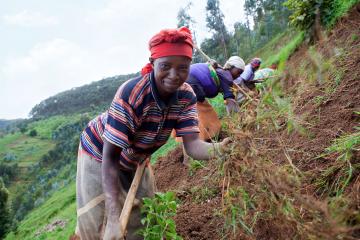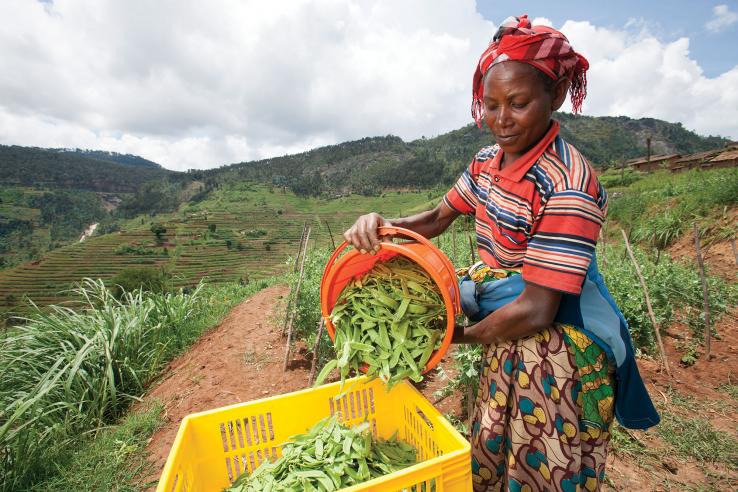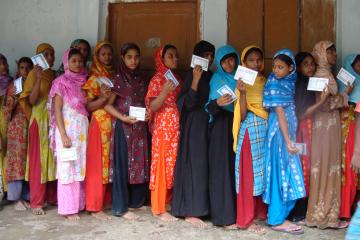
Launching a practical guide to measuring women's and girls’ empowerment

As part of the formative research that my research team and I (Rachel) conducted for a randomized evaluation on adolescent girls’ empowerment in Bangladesh, we interviewed young women about their daily lives, aspirations, and what they wanted to do that they were prohibited from doing. We also interviewed local NGOs and community partners, asking: “What does an empowered girl do differently than a girl who is not empowered?”
Some of the most frequent answers were, “she can go where she likes,” “she can negotiate with her parents,” “she is not the last to eat at home,” and “she thinks differently about what girls can do.” Distilling these rich conversations into a set of indicators that could be measured in a survey questionnaire was not simple or straightforward.
For example, many people we spoke to said that empowered girls had the ability to travel in their communities. Yet, when we talked to girls, we quickly learned that a general question like “how far away from your home can you travel alone?” would not accurately capture how their mobility was constrained, because the answer depended on what they were doing and for whom. Adolescent girls could travel to and from school alone, but they could not travel alone to do things that only had value to them, like going to local fairs.
Since empowerment is about people’s ability to make choices that matter to them, we decided to survey young women about whether they could travel alone to a list of common locations and activities, including some that were for no one’s benefit but the girl herself. Yet, by using a question and indicator that was so locally tailored, we lost the ability to compare our findings with data on women’s mobility in other contexts.
Researchers face many such tradeoffs and challenges in measuring empowerment.
How can we measure women's power to make choices that matter to them when we rarely observe decision-making directly? How can we combine outcomes like education, health, or income with measures of agency like decision-making power or self-efficacy to better measure the process of empowerment? When should we use internationally standardized survey questions and when is it better to develop locally tailored ones? Can non-survey instruments pick up useful information that surveys can’t, and when should we think about using them?
J-PAL’s newest research resource, A Practical Guide to Measuring Women's and Girls’ Empowerment in Impact Evaluations, tackles these questions and more. Gathering insights from diverse disciplines and from the experiences of J-PAL affiliated researchers around the world, the guide offers practical tips for how to measure women's and girls’ empowerment in impact evaluations. It is designed to support the work of monitoring and evaluation practitioners, researchers, and students.
Throughout the guide, we emphasize the importance of conducting in-depth formative research to understand gender dynamics in the specific context before starting an evaluation, developing locally tailored indicators to complement internationally standardized ones, and reducing the potential for reporting bias in our instruments and data collection plan. Some highlights from the guide include:
-
Seven key challenges that evaluators face in measuring women’s empowerment, along with tips for how to address them (pages 7-10).
-
Five different approaches to measuring decision-making power, a key component of empowerment, when we can rarely observe decision-making directly (pages 21-24).
-
Tips for conducting formative research before designing an evaluation to gain a deeper understanding of gender relations and the barriers that women face in a specific context (pages 13-17).
-
Tips for pretesting and piloting survey and non-survey instruments to make sure they make sense to participants and pick up relevant information (pages 37-40).
-
Tips for deciding who collects the data, when and where to interview people, and approaches and technologies that give participants options to answer privately (pages 41-44).
-
A bank of hundreds of survey questions related to women’s empowerment that J-PAL affiliated researchers have used in the past (Appendix 1).
-
A catalog of non-survey instruments that can be useful in measuring women’s empowerment and tips for when and how to use them (Appendix 2).
Recognizing that women's and girls’ aspirations and constraints are deeply tied to their specific context, the guide does not provide a single set of ready-to-go survey instruments for measuring empowerment. Instead, we outline a process for developing indicators appropriate to an individual study along with extensive examples.
In this way, we hope the guide can provide researchers and practitioners the tools to select or develop indicators of empowerment that are right for their impact evaluations.
Sustainable Development Goal 5 provides a rallying call to achieve equality and empowerment for all women and girls. To make progress towards this vision, we need a better understanding of effective policies to empower women and girls. And for that, we need to know how to measure empowerment well.
See more of J-PAL's research resources and learn more about J-PAL’s work supporting gender analysis in impact evaluations.
Some text in this post is excerpted from A Practical Guide to Measuring Women's and Girls' Empowerment in Impact Evaluations. The views expressed here are those of the authors and do not necessarily reflect those of research funders or the UK Department for International Development.



